
Station Name: CAMBRIDGE
The Royal Agricultural Society of England 1894 show
[Source: Darren Kitson]
| Date opened: |
25 June 1894 |
| Location: |
North of Mill Road (probable site) |
| Company on opening: |
Great Eastern Railway |
| Date closed to passengers: |
29 June 1894 |
| Date closed completely: |
29 June 1894 |
| Company on closing: |
Great Eastern Railway |
| Present state: |
Demolished - nothing remains |
| County: |
Cambridgeshire |
| OS Grid Ref: |
TL464577 |
| Date of visit: |
Not visited |
The Royal Agricultural Society of England (RASE) began life in 1838 as the English Agricultural Society and took on its more grandiose name a year-or-so later following, apparently, a merger of several smaller but regionally orientated societies.
The Royal Show, to use its common and more convenient name, was an agricultural show held every year from 1839 at different locations, including in Britain's larger cities, with gaps during wartime. The shows were to become massive affairs which attracted exhibitors and visitors from all over the country and included not just livestock and horses but the latest in relevant technology, business methods, foodstuffs and so on. Many exhibitors were big names in engineering and displayed and demonstrated agricultural implements, stationary and self-propelled steam engines and, in due course, internal combustion-powered machinery. Later still, communications and computer systems applicable to agriculture were exhibited. Shows usually ran for four or five days depending upon the period and other factors.
Commencing in 1968 the show was held each year at Stoneleigh Park, Warwickshire, thus breaking the 129 year-old tradition of moving around the country. The show was held for the final time in 2009 and the semi-permanent site at Stoneleigh Park was thenceforth used as the venue for the Agricultural Buildings Show.
The Royal Agricultural Society of England (RASE) held its annual show at Cambridge on a number of occasions. All bar one was held at Trumpington; in 1922 and on a number other occasions during the second half of the twentieth century. The 'odd man out' was the 1894 show, being held on Jesus Green and Midsummer Common in the centre of Cambridge. The site was thus divided by Victoria Avenue. The 1894 site was some way from the railway but nevertheless the Great Eastern Railway would have been very much the keystone of the operation.
Unfortunately, unlike the 1922 show, little of any substance is known about railway involvement. One usually dependable source of information, The Railway Magazine, did not appear until July 1897 and Great Eastern Railway records are somewhat patchy for the crucial period. Another usually dependable source of information, The Engineer magazine, is a mine of information on certain aspects of the actual 1894 show but unlike 1922, when trumpets sounded loudly for the GER, The Engineer is strangely silent on matters concerning the railway.
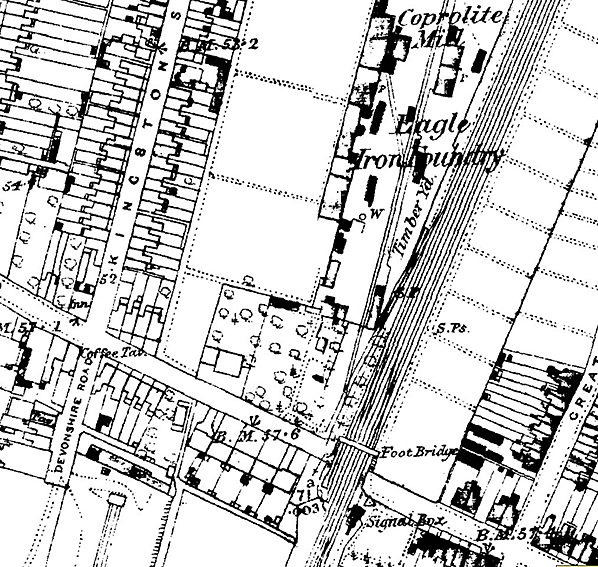 1888 1:2,500 OS map. This map was current when Jack the Ripper was busy in Whitechapel during 1888. The Eagle Iron Foundry is marked, see Cambridge Part 1, as is the coprolite works above it. Just about all the housing visible east and south of Kingston Street was constructed for railway workers. The road on the right, of which only 'Great' is visible, is Great Eastern Street. At the time this consisted of just the few houses shown and is the start of the area now known as Romsey Town. Mill Road runs from centre left to bottom right of the map and is still shown as having a level crossing with footbridge for pedestrians. Mill Road Junction signal box is shown at its original location, it was relocated to the north of Mill Road and on the down side. Note that Devonshire Road, botton left, was just a short stub-ended road at this time. The two sidings partially visible bottom left were used by the Midland Railway. These were the only exclusive facilities the Midland had at Cambridge, their goods shed being south of Hills Road and shared with the L&NWR. The plots of land east of the railway and north of Mill Road are believed to have been the site of the 1894 show platform. Curiously, the way the plots are marked out suggests the land may have originally been intended for housing. If so, it is likely the replacement of the level crossing by a bridge put an end to this scheme. 1888 1:2,500 OS map. This map was current when Jack the Ripper was busy in Whitechapel during 1888. The Eagle Iron Foundry is marked, see Cambridge Part 1, as is the coprolite works above it. Just about all the housing visible east and south of Kingston Street was constructed for railway workers. The road on the right, of which only 'Great' is visible, is Great Eastern Street. At the time this consisted of just the few houses shown and is the start of the area now known as Romsey Town. Mill Road runs from centre left to bottom right of the map and is still shown as having a level crossing with footbridge for pedestrians. Mill Road Junction signal box is shown at its original location, it was relocated to the north of Mill Road and on the down side. Note that Devonshire Road, botton left, was just a short stub-ended road at this time. The two sidings partially visible bottom left were used by the Midland Railway. These were the only exclusive facilities the Midland had at Cambridge, their goods shed being south of Hills Road and shared with the L&NWR. The plots of land east of the railway and north of Mill Road are believed to have been the site of the 1894 show platform. Curiously, the way the plots are marked out suggests the land may have originally been intended for housing. If so, it is likely the replacement of the level crossing by a bridge put an end to this scheme.
GER records, however, are not totally silent. A minute from 1 August 1893 referring to the 1894 show states simply "Consideration of work required - temporary and permanent". Use of the word 'consideration' means the company was drawing up plans and costings for the required facilities. A drawing from Stratford Drawing Office is believed to have survived showing two platforms for show traffic at Mill Road but no further details of this drawing are known at the time of writing. 'two platforms' could, however, mean an island platform and given certain factors concerning track layout at the time, the most likely site might be north of Mill Road and on the up side. This might be confirmed by a further GER minute dated 5 September 1893 which reads as follows: "The Royal Agricultural Society’s Show to be held at Cambridge in June 1894 will require extra expense; for Passengers at Mill Rd., £8500, of which £7300 will be for permanent work long contemplated; for Goods, £4538, £3600 of which will be permanent, forming part of future Goods accommodation". This expenditure was approved. It was around this time that the sidings on the up side north of Mill Road appeared, those which came to be known as Coldham's Lane Sidings and which, in altered form, survive today as EMU stabling sidings and access to the diesel depot. £8500 was a large sum of money in 1893 but the quoted minute can be interpreted as meaning only £1200 was for passenger facilities such as platforms and buildings. On the goods side, only £938 would be for facilities especially for the show.
Another minute, this time from 4 July 1893, tells us work on the Newmarket deviation line (the present line across Coldham's Common) was postponed until after the 1894 show as work could not be completed in time for the show. Until such a time as more information materialises - if any does - we will have to draw what conclusions concerning the Newmarket line we can. Work on the Newmarket deviation included slewing the line at Brookfields, pointwork at Coldham Lane Junction (railway spelling) and the replacing of Coldham's Lane level crossing with a bridge. The postponing of this work obviously meant any traffic for the show coming from the Newmarket direction would continue to use the original route into Cambridge. With this line still in use, a temporary platform north of Mill Road, on either the up or down side, would have been impossible for Newmarket trains to use without and excessive amount of shunting and disruption The Newmarket line would, of course, have provided only a fraction of the show traffic but the awkwardness for Newmarket trains to use the temporary platform suggests this traffic simply used the permanent station.
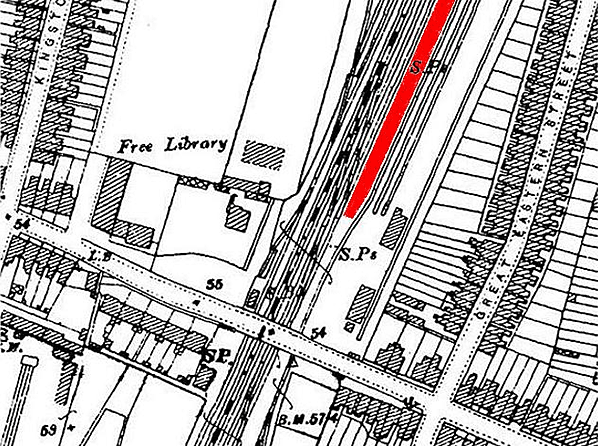 A 1902 1:2,500 OS map of the Mill Road area north of Cambridge station. Mill Road, that from centre left to bottom right, now crosses the railway via a bridge and Mill Road Junction signal box has been relocated to north of the bridge and on the down side. The Iron Foundry has gone and the sidings branching off from the down side, north of the bridge, although only one is visible above, served the corporation yard and the Co-op sidings among others. The corporation siding remained in situ and connected until the 1980s. What is believed to have been the 1894 show platform has been added to the map in red and is based upon conclusions drawn from surviving written documentation. One small question which remains unanswered is how heavy equipment was transferred from railway to showground. The question can be partly answered by the fact documents suggest the platform added to the map was used only by passengers, which means equipment and other goods were unloaded elsewhere but precisely where is not known. The area where the platform is believed to have been was to become known as Coldham's Lane Sidings. As such it was mainly used by coal trains and as holding sidings until the diesel depot was built at Coldham Lane Junction. Thereafter the track layout was significantly altered and the northern end of Coldham's Lane Sidings became the depot approach roads while the southern, Mill Road, end became used by the PW engineers, often for the stabling of tamping machines during BR days. A 1902 1:2,500 OS map of the Mill Road area north of Cambridge station. Mill Road, that from centre left to bottom right, now crosses the railway via a bridge and Mill Road Junction signal box has been relocated to north of the bridge and on the down side. The Iron Foundry has gone and the sidings branching off from the down side, north of the bridge, although only one is visible above, served the corporation yard and the Co-op sidings among others. The corporation siding remained in situ and connected until the 1980s. What is believed to have been the 1894 show platform has been added to the map in red and is based upon conclusions drawn from surviving written documentation. One small question which remains unanswered is how heavy equipment was transferred from railway to showground. The question can be partly answered by the fact documents suggest the platform added to the map was used only by passengers, which means equipment and other goods were unloaded elsewhere but precisely where is not known. The area where the platform is believed to have been was to become known as Coldham's Lane Sidings. As such it was mainly used by coal trains and as holding sidings until the diesel depot was built at Coldham Lane Junction. Thereafter the track layout was significantly altered and the northern end of Coldham's Lane Sidings became the depot approach roads while the southern, Mill Road, end became used by the PW engineers, often for the stabling of tamping machines during BR days.
One minor known detail is that the GER rented and furnished a house in connection with the 1894 show, but what is not known is where it was and for what purpose it was rented.
Other than what has been described above, surviving GER records are silent on the matter but as approval for expenditure was given on 5 September 1893 this is not especially surprising.
There has been some suggestion that Tenison Field was used in 1894. This is the area between the GER engine shed and Tenison Road. In 1886 no sidings existed on the site but by 1903 sidings did exist, including one, that nearest to Tenison Road, incorporating a run-round loop. However, Tenison Field is not Mill Road. Tenison Field is known to have been used in connection with the 1922 RASE show as photographic evidence exists but no evidence has been found, written or photographic, of any use of this site in connection with the 1894 show. That is, assuming the passenger facilities at Mill Road were actually constructed. We know the sidings, a least, were and there is nothing in surviving GER records to indicate a change of plan regarding passenger facilities.
Given that we have so many unknowns and few knowns, we will spend a little time on the show itself.
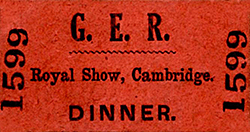 This ticket was also shown on the page covering the 1922 show. Despite it being examined by a number of relevant people (it is undated), it has not been able to confirm conclusively if it dates from 1894 or 1922. In respect of the 1922 show, railway staff based at Trumpington station and on the showground itself were issued with these tickets for meals throughout the day and according to time of day. These tickets and the meals they entitled the holder to are described in some detail on the Trumpington page. The 1894 show, irrespective of it being remote from the railway, would, without any shadow of a doubt, have had railway staff in attendance to deal with general railway enquires and to arrange the transporting of livestock, machinery, parcels and so on. It is therefore reasonable to assume meals were provided for staff in the same way as they were in 1922. This ticket was also shown on the page covering the 1922 show. Despite it being examined by a number of relevant people (it is undated), it has not been able to confirm conclusively if it dates from 1894 or 1922. In respect of the 1922 show, railway staff based at Trumpington station and on the showground itself were issued with these tickets for meals throughout the day and according to time of day. These tickets and the meals they entitled the holder to are described in some detail on the Trumpington page. The 1894 show, irrespective of it being remote from the railway, would, without any shadow of a doubt, have had railway staff in attendance to deal with general railway enquires and to arrange the transporting of livestock, machinery, parcels and so on. It is therefore reasonable to assume meals were provided for staff in the same way as they were in 1922.
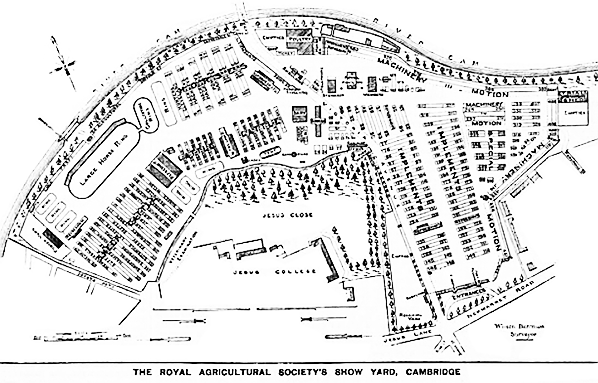
This plan (click here for a slightly larger version) of the showground dates from 15 June 1894, eight days before the show opened to the public. Unfortunately it is difficult to read but at least it has survived and is the only known plan of the 1894 show. The River Cam forms the northern boundary to the site, which is bisected by Victoria Avenue. West of Victoria Avenue is Jesus Green and right thereof is Midsummer Common. The road junction towards bottom right is that which came to be known as Four Lamps. It junctions Jesus Lane, Emmanuel Road, King Street and Newmarket Road. This section of what s marked as Newmarket Road is actually Maids Causeway and it climbs gently uphill for some distance before becoming Newmarket Road proper at the junction with Parsonage Street. The latter is not shown on the plan. Jesus College is seen bottom centre; this was originally a nunnery, St Rhadegund's, dating from the 12th century and the college was established in 1496. Rhadegund is now spelled 'Radegund' and is the origin of the name Radegund Road, a road in the Romsey area of Cambridge, as are several other roads in the same area named after associations with Jesus College.
Whatever form the railway facilities at Cambridge station took, goods, machinery and passengers would have to be transferred the 1¼ miles to the show site. As at all RASE shows and in particular those in the second half of the 19th century and onwards, the very latest in heavy machinery was exhibited and demonstrated so suitable loading and unloading facilities, with cranes, would have been required. Again, no details are known.
In remembering this was 1894, heavy items would have been taken to and from the show from the railway by road locomotives (ie traction engines) and trailers. Steam lorries were around in 1894 but were somewhat primitive and did not mature until some way into the 20th century. Lighter goods and passengers would have travelled from railway to show and back again by horse-drawn cabs or simply walked. Horse-drawn omnibuses did not appear in Cambridge until 1896 while motor omnibuses did not appear for another decade. Considering the volume of attendees (see below) it is hard to believe some form of passenger road transport was not laid on but in view of the aforementioned circumstances it is difficult to imagine what form it took. There was, of course, trams from the permanent railway station but they did not go close to the show, the nearest points being some 10 - 15 minutes walk away but they no doubt carried some of the traffic.
Some statistics for the 1894 show are known and are given below in comparison with the 1922 figures.

The 1894 show occupied 64 acres and the 1922 show 125 acres. Attendance of the 1894 show was 111,658 and this high figure was no doubt boosted by the presence on 26 June of The Prince and Princess of Wales, later to become HM King Edward VII and Queen Alexandra. The Prince of Wales' saloon, GER No.8, had been converted from a Family Saloon built in 1877. It has survived and at the time of writing awaits restoration at Embsay & Bolton Abbey Steam Railway. The 1894 attendance figures were also helped by the fine weather which prevailed, other than some rain at the start of the opening day, 23 June*.
*This date was recorded by The Engineer. The Great Eastern Railway gave the show dates as 25 - 29 June.
As with all RASE shows, much was made of the latest in technology. One of the headline stealers in 1894 was oil engines. These were an early form of internal combustion engine, usually single cylinder and reliant upon a large flywheel for overcoming inertia and as part of the starting procedure which also necessitated vapourisation of the fuel by an external device such as a spirit lamp. Two such engines are illustrated below; a stationary engine and a portable engine. They are a fascinating subject in their own right and at Cambridge in 1894 the railways would have handled the vast majority of such items
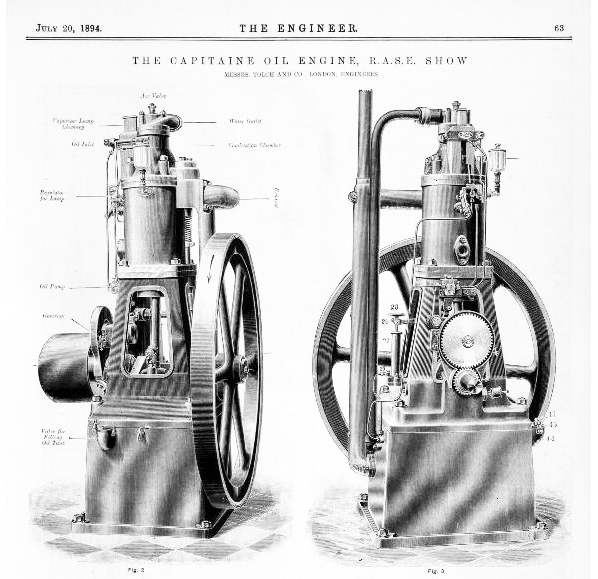
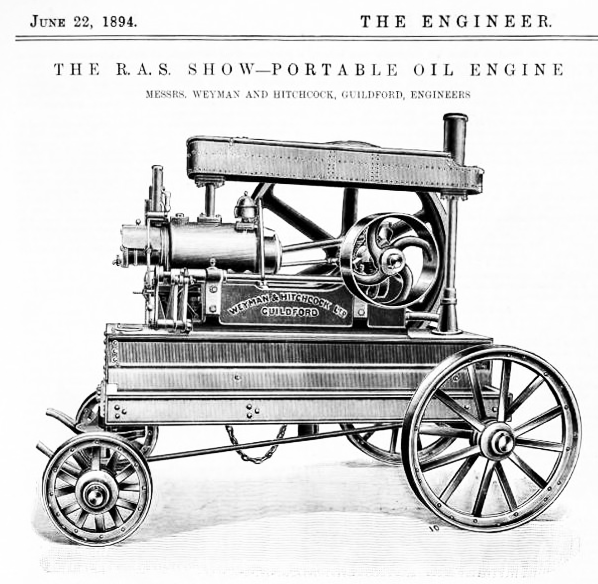
All illustrations above, ticket excepted, are from The Engineer and full details, including of the oil engines, can be read via Grace's Guide.
The 1894 show also included a ploughing demonstration using the then-new Fowler system of two steam ploughing engines and a turnover plough. Details can be seen in Graces Guide page 6 onwards. The demonstration is believed to have been staged on a plot of land off Hills Road but the precise location is not known.
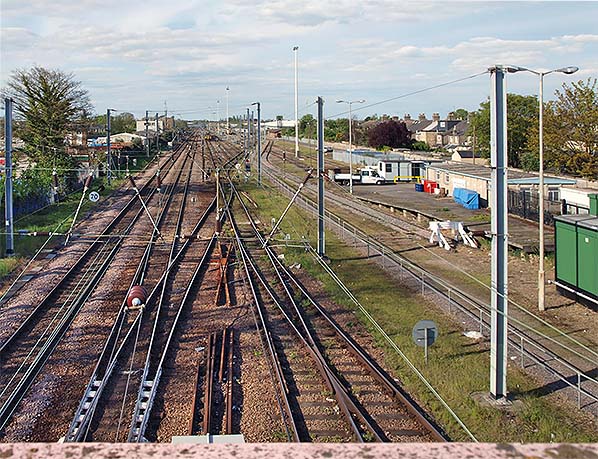 The view north from Mill Road bridge in May 2012. The area on the right is that once known as Coldham's Lane Sidings and is believed to have been, 118 years previously, the location of the temporary island platform for the 1894 show. The wooden platform seen behind the white bufferstop is, of course, a modern erection. In BR days the sidings extended right up to Mill Road bridge and there was a concrete platform where the green hut now stands plus a couple of small but more permanent buildings. When the diesel depot, which is almost invisible in the far distance, opened in 1958 the sidings were much altered; siding access was at Coldham Lane Junction, hence the sidings' name, but the diesel depot required access from the south. When the line north of Cambridge was electrified in the 1990s the layout was altered once again to that seen above. There was once also an up loop, located where the catenary masts now stand on the right, and this loop is thought to have served one face of the 1894 show platform. Coldham's Lane bridge is visible in the distance and a number of electric multiple units can be seen stabled in the right distance. The up and down main lines are the two lefthand-most tracks. The yard on the left is the corporation depot and was once served by a gated siding which passed through the gap between the two trees. Heading north, further sidings once branched off to serve the Co-op depot, Cadbury / Fry and the gas works sidings to name three. The view north from Mill Road bridge in May 2012. The area on the right is that once known as Coldham's Lane Sidings and is believed to have been, 118 years previously, the location of the temporary island platform for the 1894 show. The wooden platform seen behind the white bufferstop is, of course, a modern erection. In BR days the sidings extended right up to Mill Road bridge and there was a concrete platform where the green hut now stands plus a couple of small but more permanent buildings. When the diesel depot, which is almost invisible in the far distance, opened in 1958 the sidings were much altered; siding access was at Coldham Lane Junction, hence the sidings' name, but the diesel depot required access from the south. When the line north of Cambridge was electrified in the 1990s the layout was altered once again to that seen above. There was once also an up loop, located where the catenary masts now stand on the right, and this loop is thought to have served one face of the 1894 show platform. Coldham's Lane bridge is visible in the distance and a number of electric multiple units can be seen stabled in the right distance. The up and down main lines are the two lefthand-most tracks. The yard on the left is the corporation depot and was once served by a gated siding which passed through the gap between the two trees. Heading north, further sidings once branched off to serve the Co-op depot, Cadbury / Fry and the gas works sidings to name three.
Klass Brumann, from cyclestreets.net. Reproduced under creative cmmons licence
Sources:
- Grace's Guide
- Minutes of the Great Eastern Railway Board of Directors
- The Engineer
| Last
updated: Wednesday, 17-May-2017 09:04:04 CEST |
© 1998-2015 Disused Stations
| |

 1888 1:2,500 OS map. This map was current when Jack the Ripper was busy in Whitechapel during 1888. The Eagle Iron Foundry is marked, see Cambridge Part 1, as is the coprolite works above it. Just about all the housing visible east and south of Kingston Street was constructed for railway workers. The road on the right, of which only 'Great' is visible, is Great Eastern Street. At the time this consisted of just the few houses shown and is the start of the area now known as Romsey Town. Mill Road runs from centre left to bottom right of the map and is still shown as having a level crossing with footbridge for pedestrians. Mill Road Junction signal box is shown at its original location, it was relocated to the north of Mill Road and on the down side. Note that Devonshire Road, botton left, was just a short stub-ended road at this time. The two sidings partially visible bottom left were used by the Midland Railway. These were the only exclusive facilities the Midland had at Cambridge, their goods shed being south of Hills Road and shared with the L&NWR. The plots of land east of the railway and north of Mill Road are believed to have been the site of the 1894 show platform. Curiously, the way the plots are marked out suggests the land may have originally been intended for housing. If so, it is likely the replacement of the level crossing by a bridge put an end to this scheme.
1888 1:2,500 OS map. This map was current when Jack the Ripper was busy in Whitechapel during 1888. The Eagle Iron Foundry is marked, see Cambridge Part 1, as is the coprolite works above it. Just about all the housing visible east and south of Kingston Street was constructed for railway workers. The road on the right, of which only 'Great' is visible, is Great Eastern Street. At the time this consisted of just the few houses shown and is the start of the area now known as Romsey Town. Mill Road runs from centre left to bottom right of the map and is still shown as having a level crossing with footbridge for pedestrians. Mill Road Junction signal box is shown at its original location, it was relocated to the north of Mill Road and on the down side. Note that Devonshire Road, botton left, was just a short stub-ended road at this time. The two sidings partially visible bottom left were used by the Midland Railway. These were the only exclusive facilities the Midland had at Cambridge, their goods shed being south of Hills Road and shared with the L&NWR. The plots of land east of the railway and north of Mill Road are believed to have been the site of the 1894 show platform. Curiously, the way the plots are marked out suggests the land may have originally been intended for housing. If so, it is likely the replacement of the level crossing by a bridge put an end to this scheme. A 1902 1:2,500 OS map of the Mill Road area north of Cambridge station. Mill Road, that from centre left to bottom right, now crosses the railway via a bridge and Mill Road Junction signal box has been relocated to north of the bridge and on the down side. The Iron Foundry has gone and the sidings branching off from the down side, north of the bridge, although only one is visible above, served the corporation yard and the Co-op sidings among others. The corporation siding remained in situ and connected until the 1980s. What is believed to have been the 1894 show platform has been added to the map in red and is based upon conclusions drawn from surviving written documentation. One small question which remains unanswered is how heavy equipment was transferred from railway to showground. The question can be partly answered by the fact documents suggest the platform added to the map was used only by passengers, which means equipment and other goods were unloaded elsewhere but precisely where is not known. The area where the platform is believed to have been was to become known as Coldham's Lane Sidings. As such it was mainly used by coal trains and as holding sidings until the diesel depot was built at Coldham Lane Junction. Thereafter the track layout was significantly altered and the northern end of Coldham's Lane Sidings became the depot approach roads while the southern, Mill Road, end became used by the PW engineers, often for the stabling of tamping machines during BR days.
A 1902 1:2,500 OS map of the Mill Road area north of Cambridge station. Mill Road, that from centre left to bottom right, now crosses the railway via a bridge and Mill Road Junction signal box has been relocated to north of the bridge and on the down side. The Iron Foundry has gone and the sidings branching off from the down side, north of the bridge, although only one is visible above, served the corporation yard and the Co-op sidings among others. The corporation siding remained in situ and connected until the 1980s. What is believed to have been the 1894 show platform has been added to the map in red and is based upon conclusions drawn from surviving written documentation. One small question which remains unanswered is how heavy equipment was transferred from railway to showground. The question can be partly answered by the fact documents suggest the platform added to the map was used only by passengers, which means equipment and other goods were unloaded elsewhere but precisely where is not known. The area where the platform is believed to have been was to become known as Coldham's Lane Sidings. As such it was mainly used by coal trains and as holding sidings until the diesel depot was built at Coldham Lane Junction. Thereafter the track layout was significantly altered and the northern end of Coldham's Lane Sidings became the depot approach roads while the southern, Mill Road, end became used by the PW engineers, often for the stabling of tamping machines during BR days. This ticket was also shown on the page covering the 1922 show. Despite it being examined by a number of relevant people (it is undated), it has not been able to confirm conclusively if it dates from 1894 or 1922. In respect of the 1922 show, railway staff based at Trumpington station and on the showground itself were issued with these tickets for meals throughout the day and according to time of day. These tickets and the meals they entitled the holder to are described in some detail on the Trumpington page. The 1894 show, irrespective of it being remote from the railway, would, without any shadow of a doubt, have had railway staff in attendance to deal with general railway enquires and to arrange the transporting of livestock, machinery, parcels and so on. It is therefore reasonable to assume meals were provided for staff in the same way as they were in 1922.
This ticket was also shown on the page covering the 1922 show. Despite it being examined by a number of relevant people (it is undated), it has not been able to confirm conclusively if it dates from 1894 or 1922. In respect of the 1922 show, railway staff based at Trumpington station and on the showground itself were issued with these tickets for meals throughout the day and according to time of day. These tickets and the meals they entitled the holder to are described in some detail on the Trumpington page. The 1894 show, irrespective of it being remote from the railway, would, without any shadow of a doubt, have had railway staff in attendance to deal with general railway enquires and to arrange the transporting of livestock, machinery, parcels and so on. It is therefore reasonable to assume meals were provided for staff in the same way as they were in 1922.



 The view north from Mill Road bridge in May 2012. The area on the right is that once known as Coldham's Lane Sidings and is believed to have been, 118 years previously, the location of the temporary island platform for the 1894 show. The wooden platform seen behind the white bufferstop is, of course, a modern erection. In BR days the sidings extended right up to Mill Road bridge and there was a concrete platform where the green hut now stands plus a couple of small but more permanent buildings. When the diesel depot, which is almost invisible in the far distance, opened in 1958 the sidings were much altered; siding access was at Coldham Lane Junction, hence the sidings' name, but the diesel depot required access from the south. When the line north of Cambridge was electrified in the 1990s the layout was altered once again to that seen above. There was once also an up loop, located where the catenary masts now stand on the right, and this loop is thought to have served one face of the 1894 show platform. Coldham's Lane bridge is visible in the distance and a number of electric multiple units can be seen stabled in the right distance. The up and down main lines are the two lefthand-most tracks. The yard on the left is the corporation depot and was once served by a gated siding which passed through the gap between the two trees. Heading north, further sidings once branched off to serve the Co-op depot, Cadbury / Fry and the gas works sidings to name three.
The view north from Mill Road bridge in May 2012. The area on the right is that once known as Coldham's Lane Sidings and is believed to have been, 118 years previously, the location of the temporary island platform for the 1894 show. The wooden platform seen behind the white bufferstop is, of course, a modern erection. In BR days the sidings extended right up to Mill Road bridge and there was a concrete platform where the green hut now stands plus a couple of small but more permanent buildings. When the diesel depot, which is almost invisible in the far distance, opened in 1958 the sidings were much altered; siding access was at Coldham Lane Junction, hence the sidings' name, but the diesel depot required access from the south. When the line north of Cambridge was electrified in the 1990s the layout was altered once again to that seen above. There was once also an up loop, located where the catenary masts now stand on the right, and this loop is thought to have served one face of the 1894 show platform. Coldham's Lane bridge is visible in the distance and a number of electric multiple units can be seen stabled in the right distance. The up and down main lines are the two lefthand-most tracks. The yard on the left is the corporation depot and was once served by a gated siding which passed through the gap between the two trees. Heading north, further sidings once branched off to serve the Co-op depot, Cadbury / Fry and the gas works sidings to name three.
 Home Page
Home Page